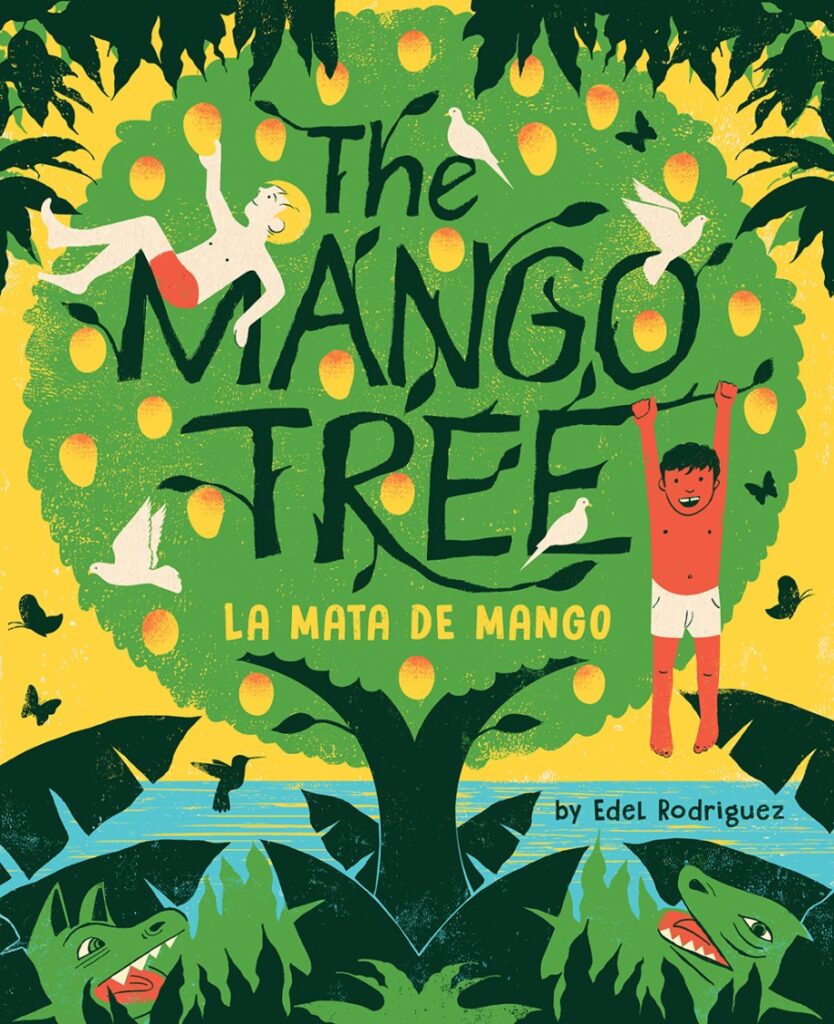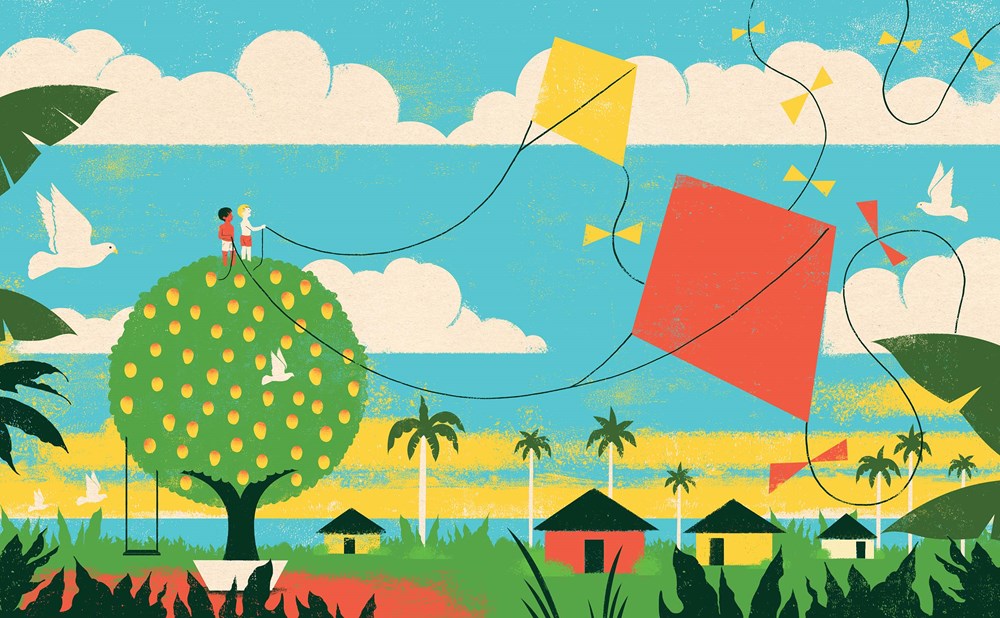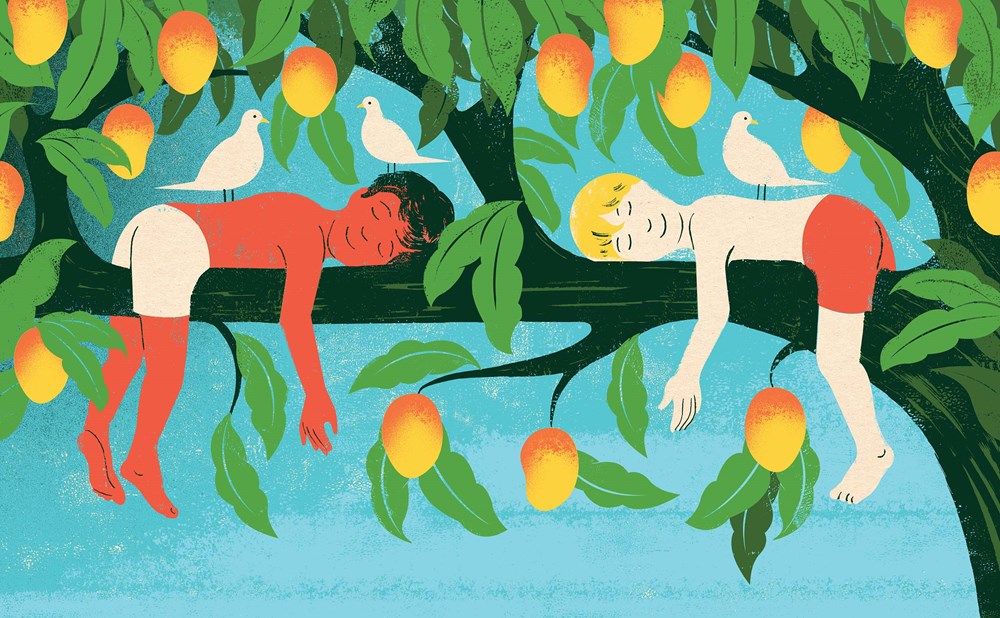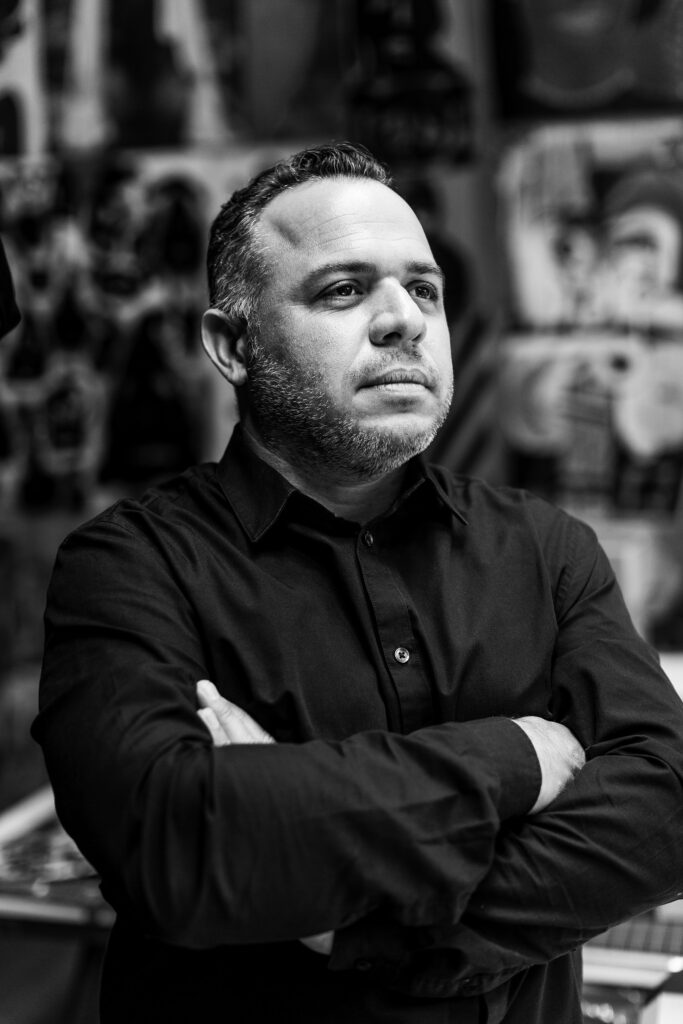
From the publisher’s description: From internationally renowned, award-winning artist Edel Rodriguez comes The Mango Tree, an enchanting wordless picture book and a moving, fantastical take on his childhood experience as an immigrant.
In a quiet village on a small island, two boys spend their days in a mango tree. High above the rest of the world, they play, take naps in the shade, and eat mangoes together. But after a huge storm sweeps one boy out into unknown waters, he finds himself alone in a strange new land, where everything is different and unfamiliar.
In this poignant, personal story, internationally celebrated Cuban American artist Edel Rodriguez brings to life his childhood experience as an immigrant to the US. Taking readers on a fantastical journey into the unknown, The Mango Tree (La mata de mango) is a tale of new experiences, the bonds that connect us to home, and a friendship that endures across time and borders.
In a New York Times book review, Alan Gratz wrote, “Rodriguez’s vivid, woodblock-printing-style illustrations had me marveling at how a simple shape becomes a leaf, a kite, a fin, a house. … In the absence of narration, readers of all ages will inhabit the child’s journey on their own terms, making “The Mango Tree” an absorbingly personal experience.”
And from a Publishers Weekly review, “Wielding visual power in this wordless picture book, Rodriguez renders a story of a childhood friendship enacted in the branches of a mango tree. … Bold graphic images, created with a combination of oil-based printing inks, sumi ink, and digital media, employ a tightly controlled palette and woodblock textures.”
Andrea: Hi Edel! Thanks so much for being on Picture Book Builders and answering a few questions about your gorgeous new picture book, The Mango Tree, which publishes today. Happy Book Birthday!
As the reviewers above noted, the illustrations in The Mango Tree are amazing. I saw that you created them “with oil-based woodblock printing inks and sumi ink, rolled out and painted on paper, combined with digital media.” Your work encompasses a wide variety of materials – why did you decide to use woodblock printing and digital media for this book?
Edel: Over the years I’ve developed a process of working by combining traditional and digital media. I like the texture, feel, and line of printmaking and drawing processes, but love the vibrant colors that can be achieved and printed via digital processes. Some of my studio work involves making mono prints and silkscreen editions and I felt that working in this manner captured the mood of this story.

Andrea: In your Author’s Note, you say that the book is based on your childhood experiences with your best friend and then immigrating to the United States. In the book, the mango tree is literally uprooted and swept away in a storm, taking the boy with it. Could you share a little about your thought process behind this choice, which took the book from memoir to fantasy? Why did you decide to make The Mango Tree wordless?
Edel: There are a many things that happen to a child when they migrate to a new country, much of it feels surreal. I wanted to capture that feeling. One day you’re playing with your best friends, in the one place you’ve known your whole life, with your pets and your toys. The next day you may be crossing a river, in a detention camp, or on a boat, and then in a whole new country an environment. There’s nothing normal about it, it kind of feels like a fantasy, as if it’s a dream. Years later you think back and wonder, did that really happen, was it all a dream? I wanted to capture the feel of that space.
I wrote a story, then thought of creating a bilingual book. In the end, I looked at all the images on the pages, without words, and and moved. The absence of words hit jus the right emotional tone for the book. When my friend and I played on The Mango Tree we were often quiet, playing, pointing, looking at birds. When I left my homeland, I was barely able to say goodbye to my best, just waved as a military jeep took me away. I was quiet for much of my migration, in detention camps, then on a boat, mostly watching, sometimes in awe, sometimes scared to say anything. And when I arrived in a new land, I barely spoke, mostly pointing, and gesturing, because I didn’t speak the new language. This wordless world I’ve created is one that reflects my reality and one that I felt all kids could relate to, regardless of what language they speak.
Andrea: You also published a nonfiction YA book last year called Worm: A Cuban American Odyssey, a graphic memoir of your childhood in Cuba and coming to America, which won a Pura Belpré Honor award (congratulations!). Was it always your intention to create both a picture book and a YA graphic version of your immigration experience?
Edel: “Worm: A Cuban American Odyssey” is a memoir about very real events with many details, politics and history. I wanted to tell stories in that book as they occurred, with all the violence, threats and complicated situations which my family has endured. I’s a 304 page nonfiction book for adults and young adults.
“The Mango Tree” is story I wanted to create for kids about friendship and the ties that bind us together. There were several tender and important stories from my childhood which I felt would be better told in other books and formats, things that I felt worked better as picture books. This story about my best friend is one of them.

Andrea: In the flap copy, The Mango Tree is described as “a tale of new experiences, the bonds that connect us to home, and a friendship that endures across time and borders.” I loved finding out that you reconnected with your childhood friend, Osledy. Is there anything else that you’d like to tell us about the book or what you’d like young readers to take away from it?
Edel: I hope “The Mango Tree” helps young readers realize how important close friendships can be, and how they can last a lifetime. I hope the book motivates them to spend more time outside, climbing trees, flying kites, playing with other kids. Close, gentle, and caring friendships are made in the real world, chasing bugs, crawling through bushes, walking in streams. I hope “The Mango Tree” inspires kids to seek closer relationships with nature and with their friends.
Andrea: Do you have any other children’s books in the pipeline?
Edel: Yes, I just finished a bilingual picture book titled “Two Worlds/Dos Mundos” which will be published by Abrams Books in 2025 and a book I’m illustrating titled “My Papi’s Hands”, written by Melissa Seron Richardson, which will be published by Little Brown in 2026. I’m also developing other picture books and graphic novels.
Andrea: I can’t wait to read them! Thanks so much for stopping by on Picture Book Builders. Edel’s publisher, Abrams Books, is giving away one copy of The Mango Tree. Please leave a comment below to enter. U.S. mailing addresses only. For more info about Edel and his works, go to https://illoz.com/edel/. Find him on socials: Instagram: @edelrodriguezstudio; X/Twitter: @edelstudio; Facebook: @EdelRodriguez.

Edel Rodriguez is a Cuban American artist and author who has exhibited internationally with shows in Los Angeles, Toronto, New York, Dallas, Philadelphia, and Spain. He has received the Gold Medal from the Society of Illustrators and for many years was the art director of TIME magazine. Books he has illustrated include Song for Jimi: The Story of Guitar Legend Jimi Hendrix by Charles R. Smith Jr., Float Like a Butterfly by Ntozake Shange, Fascinating: The Life of Leonard Nimoy, and Sonia Sotomayor: A Judge Grows in the Bronx/La juez que crecio en el Bronx by Jonah Winter. Throughout his career, Rodriguez has received commissions to create artwork for numerous clients, including the New York Times, TIME magazine, The New Yorker, and many other publications and book publishers. Rodriguez’s artwork is in the collections of a variety of institutions, including the Smithsonian Institute in Washington, DC, as well as in numerous private collections. He lives with his wife and daughter in New Jersey.

What beautiful illustrations! Thank you for sharing!
Wow! This sounds like a very special book! And I think the illustrations are just right for this story. Congratulations, Edel!
Wordless PB are fun. I let kids “read” them to me. The things they notice and how they interpret them is amazing.
Andrea and Edel, thank you for a lovely interview. As one who’s moved around a lot, living on 3 different continents, the feelings that Edel shares in Mango Tree, resonate deeply. Edel, congratulations on the Pura Belpre award and the publication of this beautiful new picture book!
What a beautiful book! The illustrations are amazing. Can’t wait to see this book!
I love the artwork and this new take on immigration. I can’t wait to immerse myself in this exciting book.
Edel, I am delighted to read about THE MANGO TREE LA MATA DE MANGO. 🥭 Looks like a lovely book with a sweet message about friendship. 📚
Thank you, Andrea.
Such an intriguing story!
Such an intriguing book!